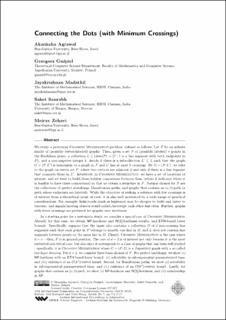| dc.description.abstract | We study a prototype Crossing Minimization problem, defined as follows. Let F be an infinite family of (possibly vertex-labeled) graphs. Then, given a set P of (possibly labeled) n points in the Euclidean plane, a collection L subseteq Lines(P)={l: l is a line segment with both endpoints in P}, and a non-negative integer k, decide if there is a subcollection L'subseteq L such that the graph G=(P,L') is isomorphic to a graph in F and L' has at most k crossings. By G=(P,L'), we refer to the graph on vertex set P, where two vertices are adjacent if and only if there is a line segment that connects them in L'. Intuitively, in Crossing Minimization, we have a set of locations of interest, and we want to build/draw/exhibit connections between them (where L indicates where it is feasible to have these connections) so that we obtain a structure in F. Natural choices for F are the collections of perfect matchings, Hamiltonian paths, and graphs that contain an (s,t)-path (a path whose endpoints are labeled). While the objective of seeking a solution with few crossings is of interest from a theoretical point of view, it is also well motivated by a wide range of practical considerations. For example, links/roads (such as highways) may be cheaper to build and faster to traverse, and signals/moving objects would collide/interrupt each other less often. Further, graphs with fewer crossings are preferred for graphic user interfaces. As a starting point for a systematic study, we consider a special case of Crossing Minimization. Already for this case, we obtain NP-hardness and W[1]-hardness results, and ETH-based lower bounds. Specifically, suppose that the input also contains a collection D of d non-crossing line segments such that each point in P belongs to exactly one line in D, and L does not contain line segments between points on the same line in D. Clearly, Crossing Minimization is the case where d=n - then, P is in general position. The case of d=2 is of interest not only because it is the most restricted non-trivial case, but also since it corresponds to a class of graphs that has been well studied - specifically, it is Crossing Minimization where G=(P,L) is a (bipartite) graph with a so called two-layer drawing. For d=2, we consider three basic choices of F. For perfect matchings, we show (i) NP-hardness with an ETH-based lower bound, (ii) solvability in subexponential parameterized time, and (iii) existence of an O(k^2)-vertex kernel. Second, for Hamiltonian paths, we show (i) solvability in subexponential parameterized time, and (ii) existence of an O(k^2)-vertex kernel. Lastly, for graphs that contain an (s,t)-path, we show (i) NP-hardness and W[1]-hardness, and (ii) membership in XP. | en_US |

